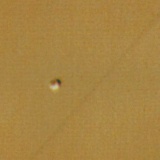 Voyager image of Prometheus. |
||
| PROMETHEUS - MOON OF SATURN | ||
| Prometheus was the son of the Titan Iapetus and the brother of Atlas and Epimetheus. Prometheus played a trick on the gods, getting them to eat bones instead of meat. He also stole their sacred fire and gave it to mankind. Zeus punished Prometheus with banishment to the Caucasus mountains where each day an eagle would eat his liver. His liver would grow back afterwards so it could be eaten over again. Prometheus was discovered in Voyager images by S. Collins and his colleagues in 1980. | ||
| Orbit | ||
|
Prometheus orbits at a distance of 139,350 kilometres from Saturn and is the inner shepherd moon of Saturn's F ring. Pandora is the F ring's outer shepherd. During a "ring plane crossing" in 1995 and 1996, when the rings of Saturn are seen edge on, Prometheus was found 20o from its expected position. Before researchers realised it was Prometheus, they thought they had discovered a new moon. Prometheus may have collided with the F ring in 1993, which altered its orbit. Alternatively, Prometheus passed close to a dense part of the ring and was slowed by the encounter. Gravitational perturbations glossary caused by Prometheus and Pandora may be responsible for the clumps observed within the F ring. |
||
 Voyager 2 image showing Prometheus and part of the faint F-ring against the background of Saturn. |
 The orbits of Pan, Atlas, and Prometheus. |
|
| Physical properties | ||
| The moon is irregular and elongated, measuring 145 x 85 x 62 kilometres. | ||
| Interior | ||
| Prometheus has a low density, indicating that it is either icy, or very porous and has lots of gaps in its rocks. It is perhaps both icy and porous. | ||
| Magnetic field | ||
| No magnetic field has been detected. | ||
| Atmosphere | ||
| No atmosphere has been detected. | ||
| Surface | ||
| Prometheus has a hummocky surface. It has a number of large craters, about 20 kilometres across, and has some ridges which seem to form the rim of a 50 kilometres diameter crater centred on an angular part of the moon. | ||
|
|
||